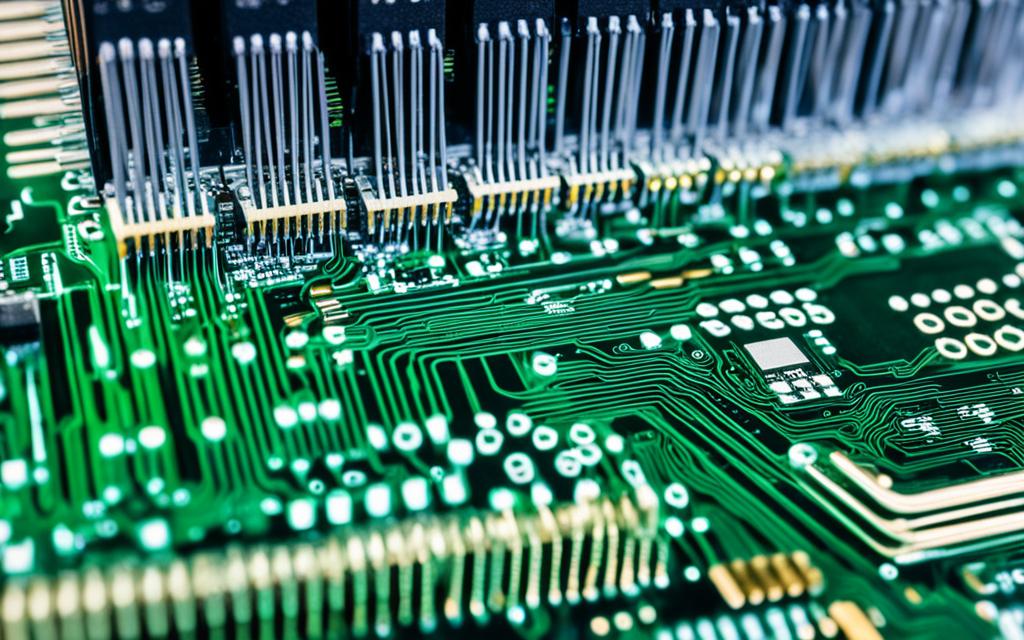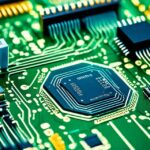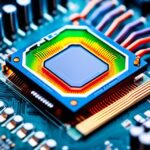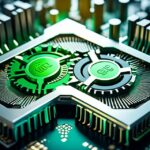Table of Contents
The Central Processing Unit (CPU) is like the brain of a computer. It’s vital for turning what we type on keyboards into commands computers can understand. When we use our devices, the CPU gets to work. It changes our keystrokes into binary code. This is the language machines speak. Without this, talking to computers would be hard, slowing down new ideas and work efficiency.
A reliable CPU is key to a computer running smoothly. It manages all tasks, making sure we can easily interact with our machine. It has a special design that includes a control unit and a math/logic unit1. Because of this, the CPU does more than just note our keystrokes. It also understands and carries them out well. This shows us how amazing CPUs are. They take simple keyboard taps and turn them into powerful actions.
Key Takeaways
- The CPU is essential for translating keyboard inputs into commands for computing.
- Data conversion processes are crucial for efficient interactive computing.
- The CPU’s architecture includes both a control unit and an arithmetic/logic unit.
- Memory (RAM) plays a key role by temporarily storing data for processing.
- Input devices range from keyboards to touchscreens, highlighting the versatility of user interaction.
The Role of the CPU in Data Conversion
The Central Processing Unit (CPU) is the computer’s heart. It oversees turning data from devices like keyboards into something the system understands. This process is crucial for modern computing to work smoothly.
Understanding the Central Processing Unit
Called the “Brain of a PC”, the processor is vital. It handles all computer operations and calculations. Fetching and decoding instructions into binary code is a2 major part of this, especially for converting data.
Importance of Data Conversion in Computing
Data conversion is key in computing. It makes software run smoothly and boosts productivity. Today’s advanced CPUs upgrade this process, meeting the needs of new software that demands quick, efficient processing3. Better CPU design means more reliable systems and better task management.
Input Signal Recognition
The keyboard is key for entering data into a computer. When we press a key, it starts talking to the computer. Electrical signals are sent to the CPU, kicking off the data entry process. These first signals are crucial because they’re turned into the commands and data the computer understands.
Electrical Signals from the Keyboard
Pressing a key sends an electrical signal inside the keyboard. This change from physical to electrical is vital for the computer and user to communicate. Keyboards have different designs, with 84 to 108 keys, to improve our interaction with computers4.
The Role of the Input Controllers
Input controllers detect electrical signals from the keyboard. They act as a bridge to the CPU, checking for keypresses and transforming them into binary codes, or keycodes. This way, the computer accurately gets and stores what we input. How well input controllers work greatly affects the computer’s reaction speed to our commands, boosting efficiency in tasks like typing or running programs.
Also, some scanners have optical recognition to convert different types of data into electrical signals. This helps the computer process information smoothly5.
A CPU Converts the Data Entered Through the Keyboard
The journey starts when the CPU gets signals from the keyboard. These signals mean that it’s time to turn the keystrokes into binary. Binary code is the basic language for computers, making them do all kinds of tasks.
The Process of Keycode Conversion
The CPU is key in turning what you type into something the computer gets6. It decodes the keystrokes. It even guesses what you’ll type next, making typing quicker and less of a hassle6. Thanks to new tech, CPUs let you change how your keyboard works. You can tweak key speeds or change what keys do for a better experience6. Plus, faster CPUs with more cores make your computer respond quicker when you type7.
Binary Code and Its Importance
Binary code is crucial because it’s how computers follow commands. The CPU turns keyboard signals into letters and numbers using codes like ASCII7. This isn’t just for typing. It helps with more complex tasks, like running programs or showing text on your screen. The system makes sure everything runs smoothly, checking for mistakes to keep data right6.
Interpreting Keystrokes
The way computers understand what we type is crucial. They use something called ASCII and Unicode to turn our typing into commands. These systems are the foundation for making keystrokes meaningful.
Using ASCII and Unicode for Character Mapping
ASCII and Unicode are key for turning what we type into actual letters and symbols. ASCII covers basic text. Unicode lets us use lots more symbols and languages. Every button we press sends a character to the computer for it to figure out.
Recognising Special Keys and Combinations
Computers also have to know about special keys and shortcuts. This includes things like the “Ctrl” key. Every key press sends two signals: one for pressing down and one for letting go8. These signals help the computer know exactly what we want it to do8.
Data Storage in Memory
After the computer gets our keystrokes, it stores this data for later. This lets apps use the info easily. The operating system checks the keyboard often, so it doesn’t miss anything we type9. Keyboards send data in small parts, showing the complex way computers read our typing9.
Executing Actions Based on Input
When you press keys, the CPU quickly starts working on what you’ve asked for. It checks and triggers special events inside your computer to do tasks in real-time. Imagine this: a CPU going at 2 GHz can handle about 200 million actions while you type just 10 characters. This shows how it deals with many things at once10.
The Triggering of Events
Typing on your keyboard sends signals to the CPU. It starts activities that turn into real actions. So, every key press doesn’t just show something on your screen. It could also do bigger tasks like pulling up data or doing sums. In places like banks, typing an account number gives you info right away. This makes users happy because they get what they need quickly5.
Data Updating and Feedback Mechanisms
Updating data is key to making sure interactions are quick and helpful. During this, the system tells users if their actions worked. This makes using computers smooth because the CPU updates things without waiting. So, you can get to your data fast. This shows how today’s systems are good at linking what you do to what the computer shows you1.
For more about how these processes work in a computer, check out this detailed guide.
FAQ
What is the role of the CPU in a computer?
The CPU, also known as the Central Processing Unit, is the brain of the computer. It carries out instructions, handles data, and turns keyboard inputs into commands. This makes computing more efficient and productive.
How does the CPU convert keyboard inputs into binary code?
Pressing a key sends an electric signal to the CPU. The CPU then turns this signal into a binary sequence, or keycode. This process is key as binary code is the basic language for software communication.
Why is data conversion important in computing?
Data conversion is vital because it enables the computer and user to interact smoothly. It lets the CPU understand complex inputs and execute commands well, enhancing productivity and making interactions quicker and more effective.
What are input controllers, and what do they do?
Input controllers are computer parts that detect signals from the keyboard. They get these signals ready for the CPU by checking for key presses, turning them into binary codes, and storing the information temporarily.
How does the CPU ensure accurate interpretation of keystrokes?
The CPU uses character mapping systems like ASCII and Unicode to make sense of the binary codes from keyboard inputs. It identifies regular and special keys, including combinations that perform unique tasks.
What happens to the interpreted data after it’s processed by the CPU?
Once the CPU has interpreted the keystrokes, it stores the data in the computer’s memory (RAM) for a short time. Then, it performs tasks based on these inputs, like updating information or providing user feedback.
How does the CPU provide feedback to users?
To improve user interaction, the CPU quickly carries out commands and offers feedback, either visually or audibly, based on what the user does. This lets users know their tasks have been completed, making for a more immersive and effective computing experience.
Source Links
- https://homepage.cs.uri.edu/faculty/wolfe/book/Readings/Reading04.htm – How The Computer Works: The CPU and Memory
- https://www.geeksforgeeks.org/role-of-processor-in-a-pc/ – Role of processor in a PC – GeeksforGeeks
- https://stackoverflow.com/questions/18180652/how-does-the-cpu-interact-with-the-monitor – How does the CPU interact with the monitor?
- https://www.geeksforgeeks.org/input-and-output-devices/ – Input and Output Devices – GeeksforGeeks
- https://homepage.cs.uri.edu/faculty/wolfe/book/Readings/Reading06.htm – How Computers Work: Input and Output
- https://softwareg.com.au/blogs/computer-hardware/a-cpu-converts-the-data-entered-through-the-keyboard – A CPU Converts The Data Entered Through The Keyboard
- https://ms.codes/blogs/computer-hardware/a-cpu-converts-the-data-entered-through-the-keyboard – A CPU Converts The Data Entered Through The Keyboard
- https://learn.microsoft.com/en-us/windows/win32/inputdev/about-keyboard-input – Keyboard Input Overview – Win32 apps
- https://stackoverflow.com/questions/72326062/understanding-how-operating-systems-store-retrieve-io-device-input – Understanding how operating systems store/retrieve IO device input
- https://bob.cs.sonoma.edu/IntroCompOrg-x64/bookch16.html – 16 Input/Output








